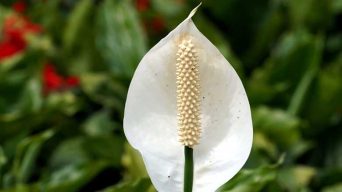Peace lily care is not difficult, and these beautiful plants can thrive indoors with little maintenance. They are known for their white flowers, which bloom throughout the year, and their glossy green leaves.
But how can you tell if your peace lily is healthy? What signs should you look for to determine whether your plant is thriving?
This article will teach you how to tell if a peace lily is healthy and how to care for it to ensure that it stays healthy for many years.
Signs of a Healthy Peace Lily Plant
Knowing the signs of a healthy peace lily (Spathiphyllum) will help you to ensure that your own plant is healthy and happy.
These are some of the things to look for:
The Peace Lily Leaves Should Be Glossy and Green, With No Brown Spots or Wilting
The first thing to look at when assessing the health of your peace lily is the leaves.
The leaves should be glossy and green, with no brown spots or wilting. If you see any brown spots or the leaves are wilting, you should look closely at your plant’s care routine.
Make sure that it is getting enough water and light. Peace lilies must be watered about once a week and prefer bright indirect light.
You should also check the soil to ensure it is not too wet or too dry. Overwatering can cause the leaves to brown and wilt, while underwatering will make the leaves turn yellow.
The Peace Lily Flowers Should Be White and Healthy Looking, With No Browning or Drooping
In addition to looking at the leaves, you should also look closely at the flowers.
The flowers should be white and healthy looking, with no browning or drooping. If you see any browning or drooping, likely, your plant is not getting enough water.
Make sure to water your peace lily about once a week, and mist the leaves occasionally to provide extra moisture.
Peace lily flowers typically bloom throughout the year, although they may bloom more during certain seasons. If you see that your peace lily is not blooming as much as it used to, it is possible that it needs to get more light.
Peace lilies prefer bright indirect light, so place yours in a spot where it will receive plenty of sunlight.
The Peace Lily Plant Should Be Generally Upright, With No Leaning or Drooping
Another thing to look for when assessing the health of your peace lily is its overall shape.
The plant should be generally upright, with no leaning or drooping. If your peace lily is starting to droop, it is likely not getting enough water.
Water your peace lily about once a week or whenever the soil feels dry to the touch.
In addition, make sure that the peace lily is not placed in a spot where it will be exposed to drafts or extreme temperature changes. These can cause the plant to stress and may lead to drooping.
The Peace Lily Roots Should Be Healthy Looking, With No Browning or Rotting
The peace lily roots are just as important as the leaves and flowers when assessing your plant’s health.
The roots should be healthy looking, with no browning or rotting. Healthy roots are typically white or light green.
If you see that the roots are mushy or discolored, it is likely that your plant is not getting enough water or that the soil is too wet.
Make sure to water your peace lily about once a week. Check the soil before watering to ensure it is not already saturated.
You should also ensure that the peace lily is planted in well-draining potting soil. If the roots sit in water for too long, they will start to rot.
The Peace Lily Has Regular Growth, With New Leaves and Flowers Appearing Regularly
The final thing to look for when assessing the health of your peace lily is its growth.
A healthy peace lily will grow steadily, with new leaves and flowers appearing regularly. If your plant is growing less than it used to or is not producing new leaves or flowers, it may need more light.
Make sure to place your peace lily in a spot where it will receive indirect sunlight for at least six hours a day.
You should also fertilize your peace lily on a regular basis to ensure that it gets the nutrients it needs to grow healthy and strong.
If you closely examine your peace lily and assess all of these factors, you should be able to tell whether or not it is healthy.
By keeping an eye on your plant and ensuring it has everything it needs, you can keep your peace lily healthy for many years.
Signs of an Unhealthy Peace Lily Plant
Knowing what to look for makes it easy to tell when a peace lily plant is healthy. However, there are also some clear signs that your plant is not doing well.
If you see any of the following signs, your peace lily is likely unhealthy and in need of some attention:
The Leaves Are Turning Yellow or Brown
One of the most common signs that a peace lily is unhealthy is when its leaves turn yellow or brown. This can be caused by several different things, including too much sunlight, too little water, or even a nutrient deficiency.
Peace lily yellow leaves are commonly caused by too much sun exposure. If this is the problem, move your plant to a shadier spot.
Brown leaves can be caused by several things, including too little water, too much fertilizer, or even pests. If you see peace lily leaves turning brown, try cutting back on fertilizer or increasing the amount of water you give your plant.
The Leaves Are Wilting or Drooping
Another common sign that a peace lily is unhealthy is when its leaves start to wilt or droop. This is usually a sign of too little water.
An underwatered peace lily will often have wilting or drooping leaves, which may also start to turn yellow or brown.
To water peace lilies, stick your finger into the soil. If it feels dry to the touch, it is time to water. Be sure to give the plant enough water so it can soak up through the roots and reach the leaves.
The Flowers Are Falling Off
If the flowers on your peace lily are falling off, it is usually a sign that the plant is not getting enough light. Peace lilies need bright, indirect sunlight to bloom well.
If you think a lack of light might be the problem, try moving your plant to a brighter spot. You can place it near a window, but keep it out of direct sunlight.
The Flowers Are Brown or Rotting
If the flowers on your peace lily are brown or rotting, it is usually a sign of too much water. When peace lilies are overwatered, the flowers can start to rot. If you see this happening, cut back on the amount of water you give your plant.
You also want to make sure that the pot you are using has good drainage. If the pot does not have good drainage, the roots can become waterlogged, leading to root rot and flower rot.
There Is Mold on the Leaves or Stems
If you see mold on the leaves or stems of your peace lily, it is usually a sign of too much moisture. This can be caused by overwatering, humidity, or poor air circulation.
If mold is the problem, try increasing the amount of air circulation around your plant. You can move it to a different spot or use a fan.
You also want to make sure that you are not overwatering your plant. Stick your finger into the soil to check the moisture level before watering.
The Plant Is Not Growing
If your peace lily is not growing, it could be a sign of several different problems. It could be that the plant is not getting enough light, water, or nutrients. It could also be a sign of pests or diseases.
If your plant needs more light, try moving it to a brighter spot. If you think it might not be getting enough water, stick your finger into the soil to check the moisture level. Water your plant if the soil is dry.
If you think your plant might need more nutrients, fertilize it with a balanced fertilizer. You can also try repotting your plant in a fresh potting mix.
If you think your plant might be infested with pests, check for common signs of pests, such as holes in the leaves or sticky substances on the leaves. You should treat your plant with an appropriate pesticide if you see any signs.
Look for signs of disease, such as yellowing leaves or spots on the leaves, if you suspect your plant has a disease. If you see any of these signs, remove the affected leaves from your plant and try to treat the plant with an appropriate fungicide.
How To Care For and Keep Your Peace Lily Healthy
Now that you know how to tell if a peace lily is healthy, you also need to know how to care for it. Here are some tips on peace lily care:
- Water your peace lily regularly. Stick your finger into the soil to check the moisture level. If the soil feels dry to the touch, water your plant.
- Give your peace lily bright indirect sunlight. Peace lilies need bright light to bloom but should not be placed in direct sunlight.
- Protect your peace lily from drafts. Peace lilies are sensitive to currents, so keep them away from doors and windows.
- Fertilize your peace lily during the growing season. Use a balanced fertilizer and apply it according to the package directions.
- Repot your peace lily every two to three years. Use a pot that is slightly larger than the previous one.
- Check your peace lily for pests and diseases regularly. Remove any affected leaves and treat the plant with an appropriate pesticide or fungicide.
These peace lily care tips will help keep your plant healthy and blooming.
Final Thoughts
Knowing if a peace lily plant is healthy is essential for keeping your plant looking its best.
By paying attention to the leaves and flowers, you can quickly tell if your peace lily needs more or less water, fertilizer, or light.
With some care, your peace lily will thrive and bring beauty to your home for years.







